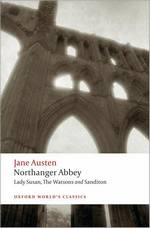 From the desk of Ellen Moody:
From the desk of Ellen Moody:
Catherine, at any rate, heard enough to feel that in suspecting General Tilney of either murdering or shutting up his wife, she had scarcely sinned against his character, or magnified his cruelty” The Narrator, Chapter 30
Jane Austen’s Northanger Abbey is the novel that almost wasn’t. We know from Cassandra Austen’s notes that her sister Jane wrote it during 1798-1799, prepared it for publication in 1803, and sold it to publishers Crosby & Company of London only to never see it in print. It languished on the publisher’s shelf for six years until Austen, as perplexed as any authoress who was paid for a manuscript, saw it not published, and then made an ironical inquiry, supposing that by some “extraordinary circumstance” that it had been carelessly lost, offering a replacement. In reply, the publisher claimed no obligation to publish it and sarcastically offered it back if repaid his 10 pounds.
Seven more years pass during which Pride and Prejudice is published in 1813 to much acclaim, followed by Mansfield Park in 1814, and Emma in 1815, all anonymously ‘by a lady’. With the help of her brother Henry, Austen then buys back the manuscript from Crosby & Company for the same sum, for Crosby could not know this manuscript was written by a now successfully published and respected author and thus worth quite a bit more. Ha! Imagine the manuscript that would later be titled Northanger Abbey and published posthumously in 1818 might never have been available to us today. If its precarious publishing history suggests it lacks merit, I remind readers that ironically in the early 1800s most viewed it as “only a novel“, whose premise its author and narrator in turn heartily defend.
“And what are you reading, Miss – ?” “Oh! It is only a novel!” replies the young lady, while she lays down her book with affected indifference, or momentary shame. “It is only Cecilia, or Camilla, or Belinda”; or, in short, only some work in which the greatest powers of the mind are displayed, in which the most thorough knowledge of human nature, the happiest delineation of its varieties, the liveliest effusions of wit and humour, are conveyed to the world in the best-chosen language.” The Narrator, Chapter 5
If this statement seems a bit over the top, then you have discovered one of the many ironies in Northanger Abbey as Austen pokes fun at the critics who oppose novel writing by cleverly writing a novel, defending writing a novel. Phew! In its simplest form, Northanger Abbey is a parody of the Gothic fiction so popular in Austen’s day but considered lowbrow reading and shunned by the literati and critics. In a more expanded view it is so much more than I should attempt to describe in this limited space, but will reveal that it can be read on many different levels of enjoyment; — for its coming of age story, social observations, historical context, allusions to Gothic novels and literature, beautiful language and satisfying love story.
Some critics consider Northanger Abbey to be Jane Austen’s best work revealing both her comedic and intellectual talents at its best. I always enjoy reading it for the sheer joy of exuberant young heroine Catherine Morland, charmingly witty hero Henry Tilney and the comedy and social satire of the supporting characters. At times, I do find it a challenge because so much of the plot is based on allusions to other novels, and much of the story is tongue in cheek. Explanatory notes and further study have helped me understand so much more than just the surface story and I would like to recommend that all readers purchase annotated versions of the text for better appreciation.
Oxford World’s Classics has just released its new edition of Northanger Abbey which is worthy of consideration among the other editions in print that include a medium amount of supplemental material to support the text. Also included in this edition are three minor works, Lady Susan, The Watsons, and Sanditon. Updated and revised in 2003, it has an newly designed cover and contains a short biography of Jane Austen, notes on the text, explanatory notes which are numbered within the text and referenced in the back, chronology, two appendixes of Rank and Social Class and Dancing and a 28 page introduction by Claudia L. Johnson, Prof. of English Literature at Princeton University and well known Austen scholar. Of the five introductions I have read so far in the Oxford Austen series I have enjoyed this one the most as Prof. Johnson style is so entertaining and accessible. She writes with authority and an elegant casualness that does not intimidate this everyman reader. The essay is broken down into a general Introduction, Gothic or Anti-Gothic?, Jane Austen, Irony, and Gothic Style, and Northanger Abbey in Relation to Lady Susan, The Watsons, and Sanditon. Here is an excerpt that I thought fitting to support my previous mention of publishing history and tone.
“Northanger Abbey is a sophisticated and densely literary novel, mimicking a great variety of print forms common in Austen’s day – conduct of books, miscellanies, sermons, literary reviews, and, of course, novels. Its ambition is fitting, because it was to have marked Austen’s entrance into the ranks of print culture. After Austen’s earlier attempt to publish a version of Pride and Prejudice failed, Northanger Abbey (then called Susan) seemed to have succeeded, for it sold for a grand total of 10 to Crosby & Company in 1803. We have seen that Austen’s entrance into the printed world, unlike Catherine’s entrée into the wide world outside Fullerton, was energetically confident: when the narrator declares that novels ‘have only genius, wit, and taste to recommend them’ (p. 23), she is clearly referring to her own novel too. This seems an audacious claim when we consider that Austen had yet to publish a novel, and a painful one when we consider that the novel, though bought, paid for, and even advertised, never actually appeared.” Page xxv
What I found most enlightening about this edition were the explanatory notes to the text which were also written by Prof. Johnson. Not only do they call attention to words, phrases, places, allusions, and historical meanings, they explain them in context to the character or situation allowing us further inside the though process or action.
115 ponderous chest: the chest is a site of spine-tingling terror and curiosity in novels such as Ann Radcliffe’s Romance of the Forrest (1791), where it holds a skeleton (vol, I , ch. iv), and William Godwin’s Caleb Williams (1794), where it holds evidence of Falkland’s diabolical crime. p. 369.
In addition to being an amusing parody and light-hearted romance, I recommend Northanger Abbey for young adult readers who will connect with the heroine Catherine Morland whose first experiences outside her home environment place her in a position to make decisions, judge for herself who is a good or bad friend, and many other life lessons that we discover again through her eyes. Henry Tilney is considered by many to be Austen’s most witty and charming hero and is given some the best dialogue of any of her characters.
“Miss Morland, no one can think more highly of the understanding of women than I do. In my opinion, nature has given them so much that they never find it necessary to use more than half.” Henry Tilney, Chapter 14
Luckily for Henry Tilney, there was one woman who used all that nature had given her with her writing when she created him. We are so fortunate that Northanger Abbey is not languishing and forgotten on a shelf at Crosby & Company in London, and available in this valuable edition by Oxford Press.
4 out of 5 Regency Stars
 Oxford World’s Classics: Northanger Abbey Lady Susan, The Watsons, and Sanditon, by Jane Austen, edited by James Kinsley & John Davie
Oxford World’s Classics: Northanger Abbey Lady Susan, The Watsons, and Sanditon, by Jane Austen, edited by James Kinsley & John Davie
Oxford University Press, (2008)
Trade paperback (379) pages
ISBN: 978-0199535545
Cover image courtesy of Oxford University Press © 2008; text Laurel Ann Nattress, Austenprose.com
Wow, this is great information I didn’t know before. I’ll be looking for this! Wait – are you going to surprise us with a giveaway at the end? Pleeeeeease! (smile)
Thank you again for all the wonderful information always posted here!
LikeLike
Janeen, thanks for your interest in the book. There is a giveaway of this title available on the introduction post to the Go Gothic event. Here is the link. Leave a comment by Oct 30th to qualify.
https://austenprose.wordpress.com/2008/10/01/go-gothic-with-northanger-abbey-introduction-day-1-giveaway/
enjoy
LA
LikeLike